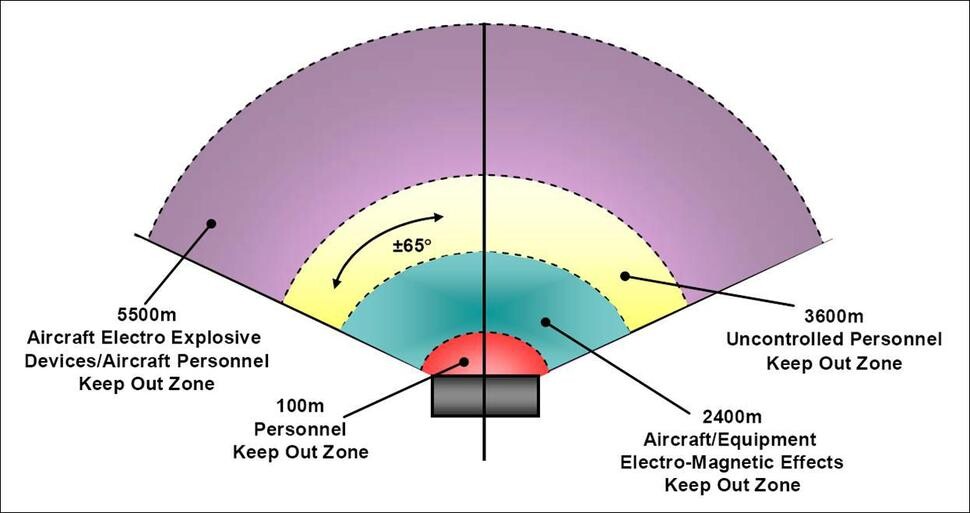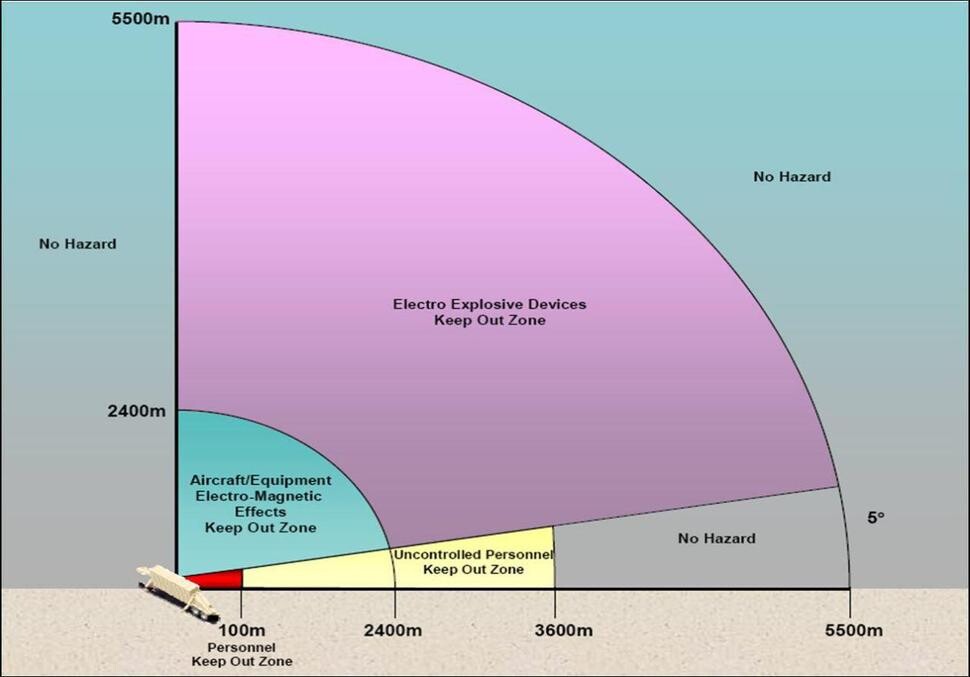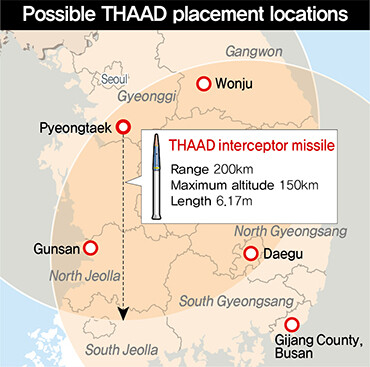hankyoreh
Links to other country sites 다른 나라 사이트 링크
[Analysis] South Korea, US announce beginning of consultations on THAAD deployment

The surprise announcement of South Korea and the US’s decision to deploy a Terminal High Altitude Area Defense (THAAD) system after North Korea’s rocket launch on Feb. 7 is now expected to generate serious controversy over procedural issues in the decision-making process, the selection of its site, and the sharing of costs.
“In response to the evolving threat posed by North Korea, the United States and the Republic of Korea have made an Alliance decision to begin formal consultations regarding . . . the viability of a Terminal High-Altitude Area Defense system operated by US Forces Korea [USFK],” the two countries announced in a joint statement on Feb. 7.
According to the statement, the aim of the consultations is “to bilaterally explore the feasibility of THAAD deploying to and operating on the Korean Peninsula at the earliest possible date.”
While the statement only acknowledged consultations on its “feasibility,” the actual deployment is widely seen as a foregone conclusion. As a gesture to possible objections from Beijing, the two countries stressed that the system “would be focused solely on North Korea” if deployed.
But China’s immediate response was one of stern objections, including a decision to summon the South Korean ambassador to China, Kim Jang-soo, to protest.
In the past, Seoul has adhered to the so-called “three no’s principle” regarding THAAD: no request had been made by Washington, no discussions had taken place, and no decision had been made. In that sense, the Feb. 7 decisions comes as a major surprise. As recently as Jan. 28, Seoul had denied a Wall Street Journal report on its alleged negotiations with the US on THAAD as “not true.”
“The announcement on Feb. 7 came after internal government discussions following a Feb. 2 request by the US,” explained a senior Ministry of National Defense official.

In one sense, the discussion appears to be a means of pressuring China into joining in on sanctions against the North. But with Chinese President Xi Jinping reiterating Beijing’s calls for a “dialogue-based solution” in a Feb. 5 telephone call with Park, the decision means Seoul is abruptly agreeing to a deployment that China has made no secret of its discomfort with. Observers have also suggested the aim may be political, with the North Korean nuclear and missile situation used as a way of addressing the sensitive issue that THAAD has become. Another complaint concerns procedural issues, since this potential diplomatic landmine was not submitted to public debate and a surprise decision was instead made behind closed doors.
For now, South Korea and the US are set to form a joint working-level agreement with members at the Ministry of National Defense bureau director level coming together to discuss the THAAD site and method of operation. As a weapons system, THAAD can be relocated anywhere in the world within 24 hours by military transport - which means it would be deployed very quickly once the two countries reach an agreement. Indeed, France’s AFP news agency quoted a Pentagon official as saying the deployment could take place within one to two weeks of a decision.
Many other issues remain before a deployment can happen - first among them the question of cost sharing.
“We’re planning to base our discussions on the terms of SOFA [the Status of forces agreement],” said a Ministry of National Defense official. If applied, those terms would leave the US bearing the cost of introducing and operating THAAD, while South Korea provides the site and infrastructure.

But many predict that the arrival of a strategic USFK weapon system will result in additional cost pressures, including talks on raising South Korea’s overall defense contribution.
An even bigger question is where the THAAD system would be deployed. The US Army’s technical measure lists the danger radius for THAAD’s AN/TYP-2 radar system as being up to 5.5 kilometers within a range of 130 degrees. That area would be subject to controls on aircraft, electronic equipment, aviators, and maintenance staff against potential exposure to electromagnetic waves.
“My understanding is that the level of electromagnetic waves around the THAAD radar accords with the safety levels specified by domestic law and the World Health Organization,” said a senior Ministry of National Defense official.
“As long as the generators are used during emergency situations and commercial electricity is used normally, there shouldn’t be any noise issues,” the official added.
For now, few sites in South Korea appear suited for THAAD’s installation. Potential candidate sites discussed so far include Pyeongtaek, Daegu, Wonju, Waegwan, and Gunsan - mostly urbanized areas without any broad stretches of undeveloped land. A concern for many is a replay of a previous situation in Daechu Village, where residents were forced to relocate to accommodate an expansion of the US Army’s Pyeongtaek base.
Indeed, a resident outcry appears very likely even without any relocation. In Oct. 2014, residents near Kyogamisaki Sub-Base in Japan responded to deployment of a THAAD radar system there by campaigning against it out of fears of the health and environmental effects of electromagnetic waves. The Japanese government ultimately pledged 3 billion yen (US$2.67 million) in US Forces Japan base reconfiguration grants over ten years to the local government in Kyotango City.
By Park Byong-su, senior staff reporter, and Choi Hye-jeong, staff reporter
Please direct questions or comments to [english@hani.co.kr]
Editorial・opinion
![[Column] Has Korea, too, crossed the Rubicon on China? [Column] Has Korea, too, crossed the Rubicon on China?](https://flexible.img.hani.co.kr/flexible/normal/500/300/imgdb/original/2024/0419/9317135153409185.jpg) [Column] Has Korea, too, crossed the Rubicon on China?
[Column] Has Korea, too, crossed the Rubicon on China?![[Correspondent’s column] In Japan’s alliance with US, echoes of its past alliances with UK [Correspondent’s column] In Japan’s alliance with US, echoes of its past alliances with UK](https://flexible.img.hani.co.kr/flexible/normal/500/300/imgdb/original/2024/0419/2317135166563519.jpg) [Correspondent’s column] In Japan’s alliance with US, echoes of its past alliances with UK
[Correspondent’s column] In Japan’s alliance with US, echoes of its past alliances with UK- [Editorial] Does Yoon think the Korean public is wrong?
- [Editorial] As it bolsters its alliance with US, Japan must be accountable for past
- [Guest essay] Amending the Constitution is Yoon’s key to leaving office in public’s good graces
- [Editorial] 10 years on, lessons of Sewol tragedy must never be forgotten
- [Column] A death blow to Korea’s prosecutor politics
- [Correspondent’s column] The US and the end of Japanese pacifism
- [Guest essay] How Korea turned its trainee doctors into monsters
- [Guest essay] As someone who helped forge Seoul-Moscow ties, their status today troubles me
Most viewed articles
- 1[Column] The clock is ticking for Korea’s first lady
- 2[Correspondent’s column] In Japan’s alliance with US, echoes of its past alliances with UK
- 3Samsung barricades office as unionized workers strike for better conditions
- 4After 2 months of delayed, denied medical care, Koreans worry worst may be yet to come
- 5[Column] Has Korea, too, crossed the Rubicon on China?
- 6[Editorial] When the choice is kids or career, Korea will never overcome birth rate woes
- 7Hong Se-hwa, voice for tolerance whose memoir of exile touched a chord, dies at 76
- 8US overtakes China as Korea’s top export market, prompting trade sanction jitters
- 9Constitutional Court rules to disband left-wing Unified Progressive Party
- 10Nearly 1 in 5 N. Korean defectors say they regret coming to S. Korea